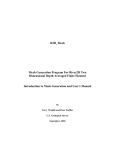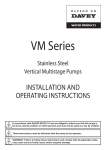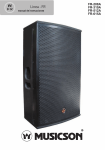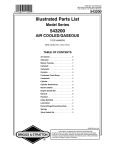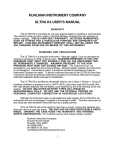Download Miller Electric STARFIRE 1E Specifications
Transcript
McDonnell & Miller Installation & Maintenance Instructions MM-615A) Series FS1 High Sensitivity Liquid Flow Switch ® (specified models only) Series FS1 OPERATION This control is an independently mounted water flow sensing device that makes or breaks an electrical circuit when flow stops or starts. Series FS1-W ! WARNING ION CAUT ING WARN • Before using product, read and understand instructions. • Save these instructions for future reference. • All work must be performed by qualified personnel trained in the proper application, installation, and maintenance of plumbing, steam and electrical equipment and/or systems in accordance with all applicable codes and ordinances. • To prevent electrical shock, turn off the electrical power before making electrical connections. • To prevent an electrical fire or equipment damage, electrical wiring insulation must have a rating of 167˚F (75˚C) if the liquid’s temperature exceeds 180˚F (82˚C). • To prevent electrocution, when the electrical power is connected to the flow switch, do not touch the terminals. • Make sure flow switch electrical cover is secured before turning on electric power. Failure to follow this warning could cause property damage, personal injury or death. SPECIFICATIONS Maximum Liquid Pressure: 100 psi (7 kg/cm2) Liquid Temperature Range (TL): 32 - 225˚F (0 - 107˚C) Ambient Temperature Range (TS): 32 - 120˚F (0 - 49˚C) Electrical Enclosure Rating: Nema Type 1 (IP 21) (All models except “W”) Nema Type 4X (IP 56) (“W” models) Maximum Velocity: 10ft/sec (3M/sec) Pipe Connection Thread Size: 1/ 2” NPT (All models except “J”) 1/ 2” BSPT (“J” models) NOTE: Switch on ‘G’ models is rated for 750mA @ 24VAC and 24VDC. This switch should only be used on low voltage (24 VAC or less) or millivolt systems. ELECTRICAL RATINGS Voltage 120 VAC 240 VAC Motor Switch Rating (Amperes) Full Load Locked Rotor 7.4 44.4 3.7 22.2 Pilot Duty 125 VA at 120 or 240 VAC 50 or 60 cycles CE Circuit Rating 7.4 (7.4)/120~ 0.3/120= 3.7 (3.7)/240~ 0.15/240= Models that meet CE Conformance: FS1-J-E FS1-W-E • This Control: is for continuous operations is not electronic has Type 1C action (micro interruption on operation) For applications with loads 0.5 and 38mA, power factors exceeding 0.65, an anticipated system switch operation rate of less than once per 5 minutes, and any one cycle greater than 3 seconds on and 3 seconds off. • LVD 73/23/EEC Additional suppression may be required for applications outside these ranges. • EMC 89/33/EEC For applications with loads between 0.5 and 3.7 Amps, power factors exceeding 0.65, an anticipated system switch operation rate of less than once per 2.5 minutes, and any one cycle greater than 3 seconds on and 3 seconds off. 2 • Declaration of Conformity Available on request. FLOW RATES Flow rates required to activate flow switch are shown in chart below. The values are calculated for sensing water (potable, non-polluted) in a horizontal pipe. Settings will vary when used to sense flow of other fluids. Flow Rates Settings Mode of Operation Flow No Flow gpm (lpm) gpm (lpm) NOTE: DO NOT USE LIQUID FLOW SWITCHES ON SYSTEMS WITH FLOW VELOCITY GREATER THAN 10 FEET (3M) PER SECOND. Max. Flow Rate gpm (lpm) w/o Paddle Damage Factory or Minimum Maximum 0.41 (1.55) 1.81 (6.85) 0.24 1.28 (.91) (4.84) 25 (95) Values are ± 10% NOTE: “L” models are set at the factory to prove flow at 1.7 gpm. The setpoint should not be adjusted in the field without consulting factory. PSI Flow Switch Capacity - FSI P DIFFERENTIAL PRESSURE GPM CAPACITY 10 20 30 40 50 60 70 80 90 8.35 11.50 13.60 15.75 17.75 19.75 21.25 23 24.25 INSTALLATION – STEP 1 - Determine the Location of the Flow Switch • The flow switch should be located in a horizontal section of pipe where there is a straight horizontal run of at least 5 pipe diameters on each side of the flow switch. • The flow switch must be installed in the upright position as shown with arrow mark on side of casting in the same direction as fluid will flow. • Some system conditions that require more than 5 pipe diameters are high viscosity fluid and high fluid velocity. 1/2" PIPE FLUID FLOW D 5xD MINIMUM 5xD MINIMUM D= PIPE DIAMETER 3 STEP 2 - Connecting the Flow Switch to Pipe a. Apply pipe sealing compound or Teflon® tape to the pipe threads. NOTE: Do not apply sealant to first threads as this switch is grounded (earthed) via the pipe mounting. b. Insert pipe threads into flow switch and turn 2 or 3 times until tight. • Place one pipe wrench on hex fitting of flow switch and one wrench on connecting piping. Tighten to following torque values. - 31 ft•lb (42 N•m) for 1/2” pipe • Repeat to connect pipe to opposite side of flow switch. 4 FLOW STEP 3 - Electrical Installation ! WARNING • To prevent electrical shock, turn off the electrical power before making electrical connections. • To prevent an electrical fire or equipment damage, electrical wiring insulation must have a rating of 167˚F (75˚C) if the liquid’s temperature exceeds 180˚F (82˚C). • To prevent electrocution, when the electrical power is connected to the flow switch, do not touch the terminals. • Make sure flow switch electrical cover is secured before turning on electric power. Failure to follow this warning could cause property damage, personal injury or death. a. Cover Removal and Installation Procedure A For FS1 models with NEMA 1 Enclosure • Using a flathead screwdriver, loosen but do not remove the two cover screws and remove the cover (A). • Place the cover on the flow switch sliding the slots behind the two loose cover screws. Push the cover down into the flow switch and using a flat blade screwdriver, tighten the cover screws to a torque of 10 lb•in (1.13 N•m). For FS1-W models with NEMA 4X Enclosure • Using flathead screwdriver, unscrew the six cover screws and remove cover. • Place the electrical connection cover on the flow switch and insert the six cover screws. Tighten the screws to a torque of 10 lb•in (1.13 N•m). b. Electrical Conduit Connection • Connect electric conduit to flow switch electrical enclosure. • Follow accepted electrical practices when installing fittings and making connections. • Refer to and follow local codes and standards when selecting the types of electrical fittings and conduit to connect to flow switch. 5 c. Determine which switch action is required for the flow switch. • “Flow” means that the switch will close circuit C.-N.O. and open circuit C.-N.C. when flow rate is increased above setpoint of flow switch. • “No Flow” means that the switch will open circuit C.-N.O. and close circuit C.-N.C. when flow rate is decreased below setpoint of flow switch. d. Based upon the mode of operation (“Flow” or “NoFlow”) required, complete the appropriate steps to connect wires to flow switch. Use a Phillip’s head screwdriver to loosen and tighten switch terminal screws when attaching wires. NOTE: Do not adjust these screws. For “Flow” Mode of Operation (Fig. 1) If the flow switch will be used to actuate a signal, alarm or other device when flow occurs, connect the wire from that device to the “N.O.” contact. Connect the “Hot” power supply wire to “C” terminal. For “No Flow” Mode of Operation (Fig. 2) If the flow switch will be used to actuate a signal, alarm or other device when no flow occurs, connect the wire from that device to the “N.C.” contact. Connect the “Hot” power supply wire to “C” terminal. Common 1 Flow Opens Circuit 3 (Common( (Normally (Normally closed ( open ( 3 LINE FS4-3 1 2 3 HOT LOAD Fig. 1 LINE FS4-3 1 2 HOT 6 Flow Closes Circuit 2 LOAD Fig. 2 SECTION 4 - Testing a. Place cover on flow switch and turn on power. Initiate fluid flow through the system. Observe the device being activated by the flow switch to determine if device is operating as required. b. Turn off fluid flow to determine if device is operating as required. ON OFF c. Repeat initiating and turning off fluid flow several times to test flow switch and device for proper operation. - If operating as required, put system into service. - If not operating as required, flow switch may need to be adjusted. STEP 5 - Adjustment Adjustment is necessary only if required flow/no flow setpoints are above factory set minimum. a. Turn off power. b. Locate adjusting screw on bottom of unit. c. Turn adjusting screw clockwise (1/8 turn) to increase setpoint. IMPORTANT: Do not attempt to lower flow switch setpoint from original factory minimum setting. Lowering (turning adjusting screw counterclockwise) the setpoint from original factory setting may cause erratic flow switch operation. Adjusting Screw 1/2" Pipe Connection d. Turn on power. e. Test the operation of the flow switch after each adjustment. 7










